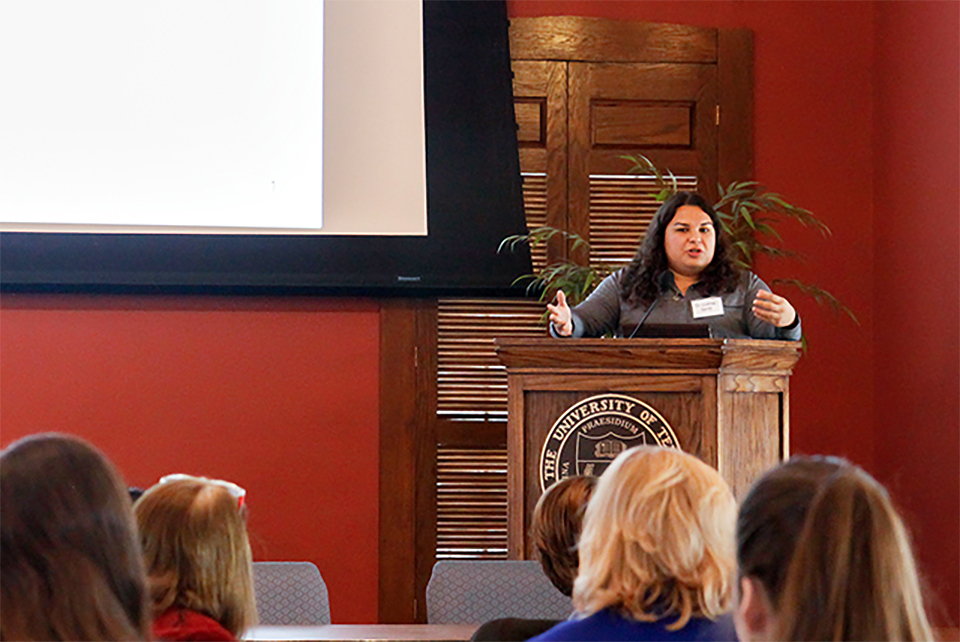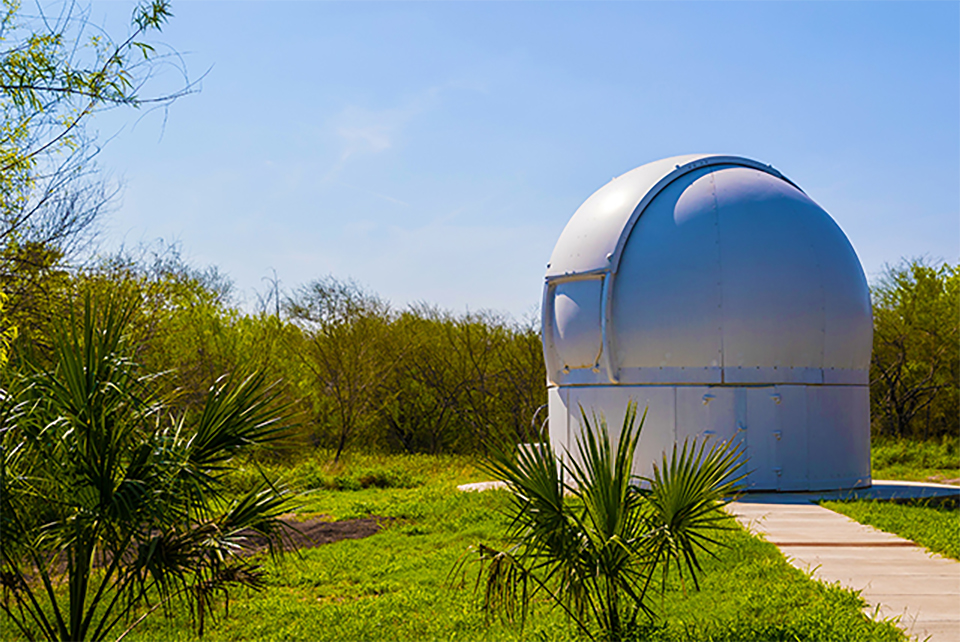Produced in 2015 in memory of Dr. Cristina Torres
Friday, May 4, 2018
Announcements, Alumni
By Victoria Brito
BROWNSVILLE, TEXAS – Known for empowering her students to always reach for the stars, Dr. Cristina Torres will be honored posthumously Saturday, May 5, when The University of Texas Rio Grande Valley names its observatory in her memory – the UTRGV Dr. Cristina V. Torres Memorial Astronomical Observatory– during an official on-site unveiling in the Resaca de la Palma State Park.
Torres, a Center for Gravitational Wave Astronomy (CGWA) research assistant professor at legacy institution UTB-TSC, Torres died three years ago. She is remembered as a scholar who eagerly imparted knowledge to her students, and as an enthusiast of science education and outreach to the community.
Dr. Mario Diaz, professor of physics and CGWA director, said it made sense to rechristen the Nompuewenu Observatory as the UTRGV Dr. Cristina V. Torres Memorial Astronomical Observatory to commemorate her courage, resilience and drive. The observatory remains under the direction of the UTRGV Department of Physics and Astronomy.
Diaz said he first met Torres in 1996, when she was an undergraduate at UTB/TSC in 1996, and at the time, she was still trying to decide whether to major in physics or engineering.
“She was taking my class and she was planning on being an engineering major, and she was very inquisitive and interested in physics. She had the type of thinking and interests that are typical of people that can go into a physics career,” he said.
She decided on physics, and got a Bachelor of Science from UTB/TSC. She went on to get a Ph.D. in physics from UT-Dallas, then did post-doctoral work at the California Institute of Technology. She was also active in the UTRGV Women’s Network, and The American Society of Physics. She focused on remote sensing, imaging, applied physics, gravitational wave data analysis, information education research, and high performance computing application development.
In her will, Torres bequeathed $10,000 to the Department of Physics and Astronomy and, at the time of her passing, a memorial fund was also created. Both of those funds were combined and contributed to the creation of the observatory, Diaz said.
“The observatory was conceived as an educational and outreach facility, and she was so passionate about that. I think it is very appropriate and very fitting to name it in her honor,” Diaz said.
She had a lot of initiative and drive, he said.
“And she had this grit that was very necessary to succeed in physics. She was very young when I hired her as a research assistant professor. She was here for less than three years before she passed away, and in those three years she was very active and engaged.”
LESSONS FOR LIFE
The students who knew her best say she was inspirational, able to light up a room.
Moises Castillo, of Los Fresnos, now a Ph.D. researcher and student in the UTRGV-UTA doctoral program, and Wahltyn Rattray, of Brownsville, a UTRGV graduate physics student pursuing a master’s degree, remember Torres fondly.
“I remember her in SETB on the second floor,” Rattray said. “I believe it was late in the afternoon and I was ready to go home, and this woman walks in and it was Dr. Torres. She was really mellow, really peaceful.
“The second thing I noticed was her shoes. She was wearing this strange fashion of shoes like foot gloves. So, I thought, ‘Who is this lady?’ I was really curious. Fortunately, I got to know her a lot better throughout the years.”
Castillo recalls Torres helping him navigate between, school, outreach and research. He felt he was spreading himself thin, and she encouraged him to focus on what was most important to him.
“‘You can’t have your thumb in two pies and eat them both. You have to let go of one to eat the other,’ is what she told me,” Castillo said. “And that was it. After she told me that, I started to focus my work on what I truly wanted, which was research and being a scientist.”
For Rattray as well, the Torres wisdom was pragmatic, and during the lowest moments of his academic career she was there for him as a guiding light.
“I was going through a lot of stuff and I had a lot on my mind. I ran into her and she looked at me with her sunglasses on – I couldn’t see her eyes or anything – and she said, ‘Wahltyn, every problem has a solution.’ It was that simple. I never forgot that because it was so valuable. I still carry that lesson to this day,” he said. “She was that kind of person. She was there when you needed her and she always had good things to say.”
She was also a keen educator who never lost sight of the lesson.
Rattray recalled a story he told in 2015, at her funeral. Torres had given him the task of taking multiple pictures of stars using a telescope, and calculating the distance between the stars.
Two weeks later, Dr. Torres asked, ‘Wahltyn, what have you done?’ And I replied, ‘Well, not much.’”
She asked him to show her what he had to that point. So Rattray showed her the few pictures he had taken without measuring any distance. Her response surprised him.
“She looked at the pictures and she was silent for a minute. Then she said, ‘OK, your next assignment is to calculate the rotation speed of the earth – using these two pictures.’
“I was astounded that she wasn’t angry. But that was so typical of her. She was ingenious, just a brilliant woman. That’s how I remember her most. She was very clever, but also very disciplined,” Rattray said.
Castillo said he was most impressed with her “go-for-it attitude.”
“She tried to make life better, and her approach was to do that through science.”


ABOUT UTRGV
The University of Texas Rio Grande Valley (UTRGV) was created by the Texas Legislature in 2013 as the first major public university of the 21st century in Texas. This transformative initiative provided the opportunity to expand educational opportunities in the Rio Grande Valley, including a new School of Medicine and a School of Podiatry, and made it possible for residents of the region to benefit from the Permanent University Fund – a public endowment contributing support to the University of Texas System and other institutions.
UTRGV has campuses and off-campus research and teaching sites throughout the Rio Grande Valley including Brownsville (formerly The University of Texas at Brownsville campus), Edinburg (formerly The University of Texas-Pan American campus), Harlingen, Weslaco, McAllen, Port Isabel, Rio Grande City and South Padre Island. UTRGV, a comprehensive academic institution, enrolled its first class in the fall of 2015; the School of Medicine welcomed its first class in the summer of 2016, and the School of Podiatric Medicine in the fall of 2022.
